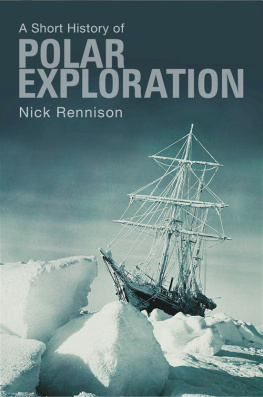William Speirs Bruce
Polar Exploration
Published by Good Press, 2020
EAN 4064066064396
PREFACE
Table of Contents
I am glad to have this opportunity of presenting to a wide public an outline of the essential facts and problems of Polar Exploration. It is not more than introductory to a more comprehensive book which I hope to write when some leisure is afforded from the more real work of exploration and research. I must also note that it is not intended to be in any way a history of Polar Exploration.
The book is simply a "traveller's sample," revealing to some extent what is in the great "warehouse" of the Polar Regions. It is based, firstly, on the author's personal experiences during nine polar voyagestwo to the Antarctic Regions, viz. in 189293 and 190204; seven to the Arctic Regions, viz. in 189697, in 1898 (two), in 1899, 1906, 1907, and 1909; secondly, on many personal conversations with living polar explorers during the past twenty years, including several conversations and correspondence with the veteran Sir Joseph Dalton Hooker, O.M., who accompanied Sir James Clark Ross on his ever-memorable Antarctic voyage from 18391843, as well as conversation and correspondence with the leaders and many members of the staffs of every recent polar expedition.
Consequently the personal note predominates, and those parts of the Polar Regions which the author has visited are dealt with in greater detail than those which he has not yet had an opportunity of visiting. But the attempt is made to deal with facts and problems that are of general rather than local interest.
I have to acknowledge kindly help in the production of this little book. Dr. R. N. Rudmose Brown has revised the text, especially the botanical section, and framed the index ; Mr. J. Y. Buchanan, Mr. R. T. Omond, and Mr. J. Boland have revised the sections dealing with the Physics of the Sea, Meterology, and Astronomy. Mrs. Bruce has been my amanuensis throughout.
William S. Bruce.
Scottish Oceanographical Laboratory
Edinburgh, 1911
CHAPTER I ASTRONOMICAL FEATURES OF THE
POLAR REGIONS
Table of Contents
From the earliest days of European civilisation it has been customary to define the direction of the sun at noon as well as the opposite direction. South and north are the terms that have been used by north-western Europe: hence North Pole for that end of the earth's axis towards which Europe stretches, and South Pole for the other end of the axis. Now there are very definite peculiarities of these two mathematical points, and I give a few of these to set the reader thinking.
1. The sun is continuously above the horizon for six months, from our spring to our autumn equinoxes, and continuously below the horizon for the other six months.
2. But there is only one time, namely noon, because all longitudes converge at the North Pole: whether it be light or dark it is always noon, because the sun is always due south.
3. Though there is only one time there are different seasons, because these depend on the position of the earth in its orbit and on the inclination of the polar axis to the plane of the ecliptic.
4. The apparent path of the sun is an ascending spiral from the vernal equinox till the summer solstice, and a descending spiral from the summer solstice till the autumnal equinox. Thus it is possible to take meridian altitude of the sun during the whole summer six months at the North Pole, at any moment, or at every moment, no matter where the sun is in the spiral. Exactly the same thing may be said of the moon when she is north of the Equator.
5. The greatest possible altitude of the sun above the horizon is about 23 degrees (actually at Greenwich mean time, 1911, June 22nd, 2h p.m., 23 27 9.8). It reaches this altitude only at that date.
6. The constellations never set at the North Pole, their apparent paths (neglecting their own very tiny movements) being in circles, round the Pole; like the sun, they are always south of the North Pole.
7. When standing at the North Pole it is impossible to look in any other direction along the earth's surface but south. To the left or to the right, behind or in front of the person standing at the North Pole the direction is always south.
These conditions apply equally to the South Pole, except that the terms north and south have in every case to be reversed. It is very important to get a proper grip of these facts if one is to have a proper conception of where the Polar Regions are, and to account for various special phenomena peculiar to these two parts of the earth.
Theoretically it is convenient to define the Polar Regions as those areas that lie round about the North Pole and round about the South Pole, within the Arctic and Antarctic Circles, which are defined by being those circles of latitude where the sun on midwinter-day does not rise and where on midsummer-day it does not set.
In contrast to the tropical regions, where the sun is always vertically overhead at some place at noon on two days (at the north and south limits on one day) every year, and always reaches in every part an altitude exceeding about 43 degrees, in the Polar Regions the sun is never more than 23 degrees above the horizon. On account of this great obliquity of the sun's rays in the Polar Regions the sun has less heating power and the regions are colder, while in winter intense cold prevails because of the entire absence of the sun.
Having now obtained a general idea of the position of the Polar Regions on the earth's surface let us pass on to consider their general features. And the Antarctic Regions are considered first, because it was there, about twenty years ago, that I first received my polar baptism and first learnt what the Polar Regions were.
CHAPTER II THE POLAR REGIONS
Table of Contents
I have defined the Antarctic Regions as lying within the Antarctic Circle, that is, south of 66 S. latitude, but in 1892, on board the Scottish whaler Balna, I found that this definition broke down, for we fell in with polar conditions before we reached latitude 60 S., some 500 miles south-eastward of Cape Horn, in the neighbourhood of the South Shetland Islands. My impressions of the circumstances are as vivid to-day as then, and more vivid, perhaps, than many other even more striking incidents during that and subsequent voyages.
Sailing south-eastward from the Falkland Islands across the breezy southern ocean, we came into weather, although it was mid-summer, having temperatures about freezing-point. This cold weather was accompanied by fairly frequent fogs which occasionally were very dense, till one day, when we were about 80 miles north-east of the South Shetland Islands, the fog divided, opening up a vista at the far end of which a gleam of sunshine revealed a huge shadowy icebergbrilliantly white. Sailing on we came nearer to the berg, which was several miles off when we first sighted it, and found it to be a mass of ice which probably rose fully a hundred feet out of the water and was about half a mile long. The top of it looked as flat as a billiard table, and the sides were vertical white cliffs; some cracks, mostly vertical and lenticular, were strongly defined, because in them was to be seen the most brilliant and intense blue one can imagine. At the water-line the ice cliff was worn by the lashing of the relatively warm waves (32.3 F.), and here and there were caves at sea-level where green intermingled with intense blue. Into these caves the water rushed with a resounding roar, until each cave was a seething cauldron, and in some cases the spray from these caves rose high into the air. The sea was literally swarming with Cape pigeons and blue petrels, while great finner whales played and spouted in the vicinity of the ship. The Cape pigeons were so numerous that, on putting a small piece of fat over the side of the ship, one could catch them quite easily with an angler's landing-net. The silk tow-net showed that the water was swarming with a small shrimplike creature called














